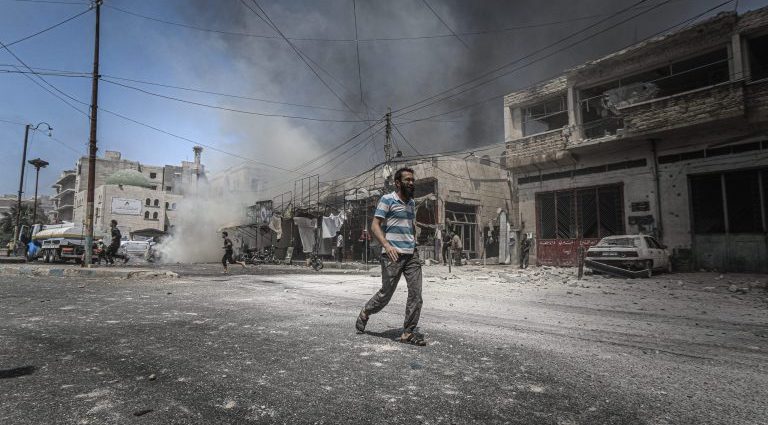
Infighting among jihadist rebel forces has been a recurring theme throughout the Syrian civil war, with shifting alliances among armed factions producing a trail of destruction throughout the country’s north.
But the latest round of clashes, between Hayat Tahrir al-Sham (HTS) – the former al-Qaeda branch that controls most of Idlib province – and the Third Legion, a merger of Turkish-backed factions, could be among the most consequential.
The fighting, which began on October 11, has so far allowed HTS to seize Afrin, a strategic city in rural Aleppo that had been held by Turkish-backed forces since its capture from Syrian Kurdish forces in 2018. However, the goal of HTS, which is led by Syrian militant commander Abu Mohammed al-Golani, goes beyond mere territorial expansion.
The group is trying to use this opportunity to force the Third Legion, among others, to agree to a merger with the Salvation Government, a civilian structure established by HTS to help it govern its territories.
While creating a unified civil administration for all rebel areas might not be possible now, the ongoing infighting will undoubtedly redefine power dynamics in Syria’s northwest.
The new clashes were triggered by the assassination of a prominent Syrian activist and his pregnant wife, on October 7, in al-Bab. The investigation, led by the Third Legion of the Turkish-backed Syrian National Army (SNA), found evidence that the victims were killed by a hit squad linked to the Hamza Division, another SNA group.
The Third Legion tried to capitalize on the public anger caused by the discovery and launched a campaign to disband the Hamza Division, starting with the group’s headquarters in al-Bab. HTS, which viewed the clashes as an opportunity to expand its own influence, allied itself with the Hamza Division. The Sultan Suleiman Shah Division, an infamous SNA group, also joined this coalition to settle a score with the Third Legion.
While the Third Legion had initial success against the Hamza Division, HTS’s intervention quickly tipped the balance into the division’s favor. Within hours, HTS and its allies took control over Afrin and its surroundings.
HTS’s swift victory does not come as a surprise. That’s because the group is by far the strongest remaining rebel faction in northwestern Syria thanks to its size, discipline, unified structure, and weapons.
In addition, HTS has a long history of brokering deals to divide and neutralize its enemies. As soon as the fighting started, the jihadist group reportedly reached out to factions within both the Third Legion and the SNA to ensure that they didn’t join the fray.
But none of this would have been possible if it weren’t for Turkey’s apathetic response to the recent HTS incursion. HTS has long sought a wider economic and security role in areas beyond Idlib, but until this month, Turkey’s objections had prevented the group from achieving that. This was evident last June, when Turkey reportedly asked HTS to withdraw from Afrin’s southwest shortly after establishing a foothold there.
This time, however, Turkey made no similar demand. The lack of response has been interpreted by many as a green light for HTS to try and stabilize the region, which has been suffering from chaos and insecurity.
Still, Ankara doesn’t seem willing to allow HTS to go beyond Afrin. Various sources have reported that on October 14, Turkey used its influence to broker a truce between HTS and the Third Legion. Despite a brief pause in fighting, clashes erupted again with more intensity, and HTS quickly advanced toward Kafr Jana, in what appeared to be a move to capture Azaz, northeast of Afrin close to the Turkish border.
HTS’s ability to make quick gains has pushed Turkey to intervene once again; Ankara has called on the jihadist group to withdraw from Kafr Jana. Unlike Afrin, HTS’s capture of Azaz could trigger more community resistance, hinder international aid operations, and diminish the administrative capital of the opposition’s interim government.
Whatever comes next, HTS has already made several strategic gains that are difficult to reverse. First, it has established a foothold outside Idlib, marking the beginning of a likely expansion phase. While the next target for the upcoming campaign might be Azaz, there’s little doubt about the group’s desire to broaden its influence into other rebel-held areas further east.
Second, the recent territorial gains will likely allow HTS’s affiliate Salvation Government to co-opt local governance in and around Afrin. Doing so would further advance HTS’s goal of creating a unified administrative structure for all rebel-held areas.
Third, HTS’s expansion to Afrin would likely allow the group to redefine its relationship with Turkey, which is currently the only foreign actor capable of reshaping northwestern Syria.
Finally, the latest clashes further polarized and divided HTS’s main rival, the SNA. As a result, SNA leadership no longer seems able to mediate or solve the problems among its components, which will make HTS’s divide-and-conquer strategy easier to implement.
Although no one can predict with certainty what the future holds for Syria’s northwest, HTS’s tightened grip over the region will have serious implications for the people living there.
The group’s designation as a terrorist organization, by many governments including the US and Turkey, will likely reduce the number of humanitarian organizations willing to operate within its areas of control. It will also strengthen the Syrian government’s rhetoric about countering terrorism, leaving civilians to pay the price for HTS’s ambition.
This article was provided by Syndication Bureau, which holds copyright.

